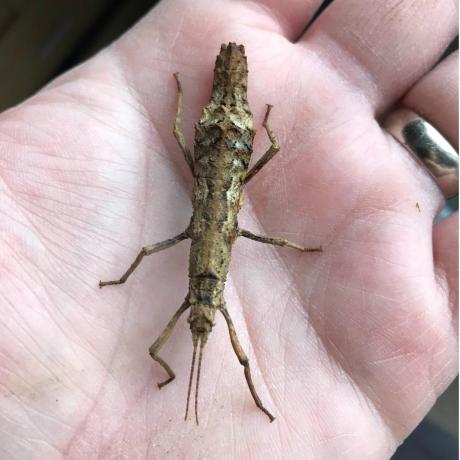

A small, long lived and slow growing species of stick insect. Easy to keep and propagate.
| PSG | 248 |
|---|---|
| Origin | Hong Kong |
| Adult Size | Up to 4cm |
| Difficulty | Easy |
| Lifespan | Up to 2 years |
| Food Type | Bramble, Rose |
This species has a bulbous shape body around the rear legs. This shape tapers gently inward towards the head and again but more sharply toward the rear. Adult females can reach sizes of up to 4cm. Overall the body colour is varying tones of brown with cream patterning along the flanks and parts of the upper legs.
These insects have an unusual defensive strategy and when they feel threatened will go rigid and fall to the ground. They can remain motionless for several days, so caution must be taken to not accidentally throw them away by thinking they are dead.
We’re unable to find the exact location and habitat they were found in, but we know these insects originated from Hong Kong.
Housing this species is very easy, they require a simple mesh, screen cage or well venitlated glass terrarium with a least 20cm in height (to allow for successful moulting). They can be kept quite satisfactorily at a room temperature of 20-24 C (68 -75 F) but if temperatures drop below this for long periods then some external heating equipment may be required.
Provide a moderate to high level of humidity by spraying the enclosure daily with a hand or pressure sprayer. You will find stick insects drink moisture from the food plant leaves and benefit from the increased humidity when moulting their skin.
For substrate we’d advise using paper towels at the bottom of the enclosure for nymphs and moving them over to coco fibre bedding once they reach adult. The primary reason for this change is so females can deposit their eggs into the substrate once they are mature. Please be aware that mould will kill insects and caution must be taken to change substrate if it becomes contaminated.
Dwarf Chinese stick insects eat plant matter including Bramble and Rose. Collect the food from areas where pesticides are unlikely to have been used and cut the stems to approximately the correct height for the enclosure. Place your chosen food type in an empty glass jar half filled with water, this will prevent the plant matter from wilting. Change the food weekly or more frequently if required.
Dwarf Chinese Stick insects will reproduce in captivity even in the absence of a male, this is called parthenogenetic reproduction. Mature females will lay unfertilised eggs, that will still develop and hatch into nymphs without mating ever taking place. Any of the offspring produced asexually will be female and are often clones of their parents.
When females reach adulthood they will begin to lay relatively small numbers of oval shaped eggs (ova) around 3.5mm in size, these will be deposited on top or within the substrate. The ova are brown in colour and covered in hairs. They can be carefully collected from the bottom of the cage and separated from any fallen plant matter and dried faeces; using small tweezers.
Incubate ova in vermiculite inside of a sealed container at a room temperature of 20-24 C (68 -75 F). Try to maintain a humidity level of around 85%; often they will take five or more months to hatch. If you don’t wish to incubate them, dispose of them humanely by freezing them shortly after laying.
Raise newly hatched nymphs separately to your adults for ease of maintenance and offer fresh food frequently.